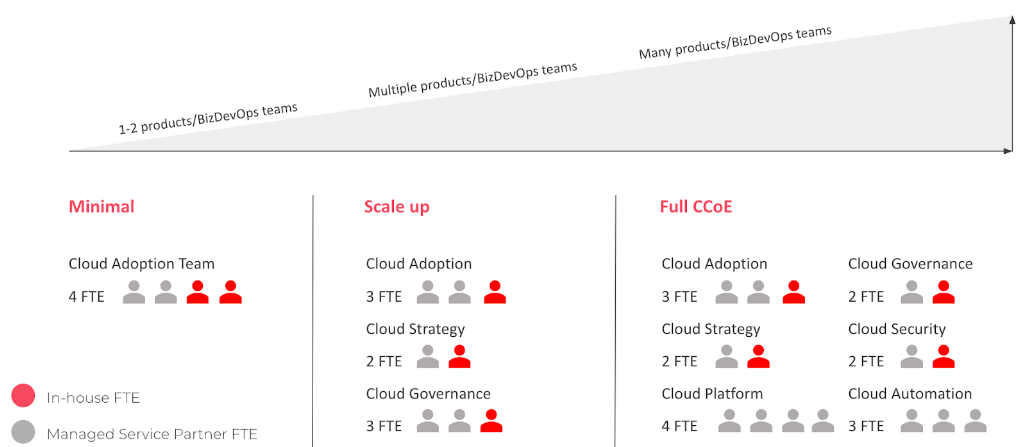IDC estimates that by 2023 over 40% of enterprises will replace outdated operational models with cloud-centric models that facilitate, rather than inhibit, organisational collaboration — resulting in better business outcomes. Today’s most progressive organisations will outperform their competitors through the advanced use of the cloud, and as a result, their ability to drive digital innovation and real business benefits from cloud usage.
To ensure cloud adoption success, your enterprise must have in place the necessary skills and structure. The best way to achieve this is by setting up a Cloud Centre of Excellence (CCoE) with the primary duty of accelerating cloud adoption across your business. By “adoption,” we don’t mean simply setting up the cloud capability but also making sure that it will be used and governed in the right way. A CCoE should encourage the increase of knowledge and experience with cloud computing across your entire organisation in order to make that happen.
What is a Cloud Centre of Excellence?
There are various definitions of what a CCoE is. Moreover, vendors define the CCoE differently. However, each vendor agrees that a common function of a CCoE is governance. At Devoteam, we view the CCoE as a body (see Figure 1) made up of people and teams responsible for platform management, cloud adoption, automation, strategy, governance and risk security and compliance, that work together to improve the top-to-bottom usage of cloud in an organisation.

The components of the CCoE are the following:
- Cloud Strategy
- Cloud Governance
- Cloud Adoption
- Cloud Automation
- Platform Management
Furthermore, Figure 1 illustrates so-called BizDevOps components. This is a way of organising the work around one product and the practical utilisation of the Cloud for the purpose of Innovation is utilised through these teams.
The CCoE components can be organised in a CCoE team or they can be more distributed and connected to other areas in the organisation for a potentially bigger impact related to a specific topic. For example, Cloud Strategy can be organised in relation to IT and Digital planning, strategy alignment and portfolio management. Cloud governance can be organised in relation to other governance controls, e.g. security controls, architecture controls, etc. and can be seen as an alignment of a full Agile, DevOps and Cloud Operating Model.
In our experience, the fact that a number of governance areas in a new modern Digital Operating Model are overlapping can make it harder to get these things done. Our advice is to get everything aligned in an Operating Model. Don’t have centres of excellence on the side but have them integrated into the same Operating Model.
Why is a Cloud Centre of Excellence a good idea?
If your enterprise has recently moved operations to the cloud, you might not be achieving the desired operational agility. However, the CCoE approach can show you a way to unlock the cloud’s full potential.
From a business perspective, a CCoE enables you to deliver products and services to your users without shackling your product team with the traditional operational processes used on-premise.
In our view, establishing a CCoE is the best way to ensure that the move into, as well as the management of, cloud adoption is as seamless and beneficial as possible. From setting the right processes to helping your team make critical decisions, a CCoE offers the structure and approach required for success across both business and technical dimensions.
Upon successful implementation, these functions can produce reductions in time to market (TTM) – which will no doubt please your product team. Furthermore, as your team becomes more comfortable with team practices, quality indicators will naturally improve, including performance efficiency, reliability, customer satisfaction, maintainability, and security. In our experience, these acquired benefits in efficiency, agility, and quality become particularly important if your business plans to implement large-scale cloud migration efforts.
Will we still need a CCoE if we have Cloud Managed Services?
The short answer is yes. Even with outsourced managed services the organisation needs to take ownership. Otherwise, the experience is that Cloud quickly is seen as a technical feature affiliated with the IT department and not a business critical opportunity that should involve the organisation as a whole.
Cloud-managed service providers can take care of everything, from managing cloud security and computing to storage, network operations, application stacks, and more — freeing organisations to devote more time to focus on their business.
However looking at the components of the CCoE in Figure 1 it’s clear that some of the CCoE components can be handled well by the Managed Service Provider, while other components should have shared responsibility and some will require the business to take ownership. Platform and Automation components are clear candidates to be handled by the Managed Service Provider. For the other areas, it depends on the company’s Digital Operating Model and Digital Organisation what should be in-house or outsourced. The choice is an important strategic decision that should be made.
Cloud computing has changed not only the way IT works but also how services are managed. Further, the virtualization of the cloud ensures that companies can reap the benefits, including vast scalability, increased agility, and lower costs. Cloud-managed services providers (MSPs) play a vital role in helping organisations recognize and leverage these benefits.
How do you get started on your CCoE journey?
We recommend a model where the CCoE capabilities are built up gradually in phases in order to establish the core processes, roles and capabilities in an MVP type of set-up and gradually build from there growing the capabilities. In figure 2 an example scaling model is illustrated.

The sizing of the steps in Figure 2 is related to the number of products and BizDevOps teams that are integrated into the model. It starts with one or two products and teams with a focus on the CCoE role of Cloud Adoption. In the next step, more products and teams are added and also more CCoE roles, including Cloud Strategy and Cloud Governance. Finally, this grows into a full CCoE that can handle multiple products and BizDevOps teams, with all the CCoE rolls from Figure 1 included.
Figure 2 also illustrates that in every step there is a mix of headcount from the organisation (red) and from the Managed Service Partner (grey). The mix in Figure 2 is only an example but it highlights that it’s an important decision to make. The Managed Service Partner can help you scale and can remain in roles that you do not intend to have as internal roles and at the same time you can build the internal capabilities and processes in the areas where it’s important to have the control and the capabilities in-house. The choice is yours.
Conclusion
In our opinion, a CCoE model can create a monumental shift in IT when implemented successfully. Using a CCoE approach, IT serves as a broker, partner, or representative to your business. CCoE is a world away from the traditional view of IT. Even with outsourced managed services the organisation needs to take ownership of the CCoE. Otherwise, Cloud is seen as a technical feature and not a business-critical opportunity that should involve the organisation as a whole. The CCoE capability can be built in phases starting with an MVP and a few products and growing to multiple products and the full set of CCoE capabilities.

Find this article interesting?
Check out our digital innovation with cloud e-book to learn more.